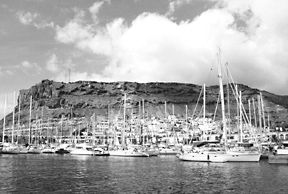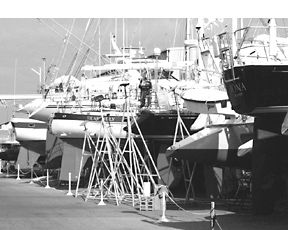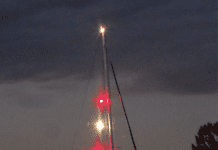It was strange to be back into the Atlantic Ocean after a three-year absence. Looking west, we felt that if we squinted really hard, our old homeport of Newport would loom on the horizon, even though it is almost 2800 miles away.

We are 90 percent of the way around the world. We sometimes feel every mile of it.
Strangely, we lack a sense of urgency in our preparations for this final leg. We are—dangerously perhaps—low key, almost relaxed, even though we are looking ahead to a passage of some 2,800 miles. We have checked over the rig, serviced the engine, done most of the provisioning. We are already watching the weather carefully, even though it’s about 10 days before we think we will leave. Maybe, just maybe, we’re starting to get this ocean-crossing thing down.
We remember good friends, however, who lost their rig just a few hundred miles from the end of their circumnavigation last year. We remember, and we check the rig again. In fact, we check everything again. Now, a little of the tension is coming back, and it feels more normal.
The good thing about this passage is that the later you wait, the better your weather gets.
After we arrived in the Canaries, but before the weather-wait started, I needed to make a trip to the US for some America’s Cup work. It was my first time back home in a year and a half, the first time since last September 11 changed the way we will always look at things.
Even if we had somehow been totally insulated from the events of September 11, we would know things were different. In Europe, airplanes are mostly full, and airline security seems normal. Once headed towards the US, however, things definitely were different. In Amsterdam, each passenger boarding a flight to America was individually questioned, and some had their bags thoroughly searched. This was only the beginning.
Once back in the US, I boarded a nearly empty cross-country flight. In the airport, things seemed a little grim. There was little smiling or banter. You had the feeling that no one was flying who didn’t really have to fly. There were few families.
The passengers eyed each other suspiciously. A tall, Middle-Eastern looking man in a flight jacket was searched from head to toe. His carry-on bag contained a pilot’s uniform. He was merely a corporate pilot on his way to work, but seeing him board made me uneasy. Was I becoming a paranoid, a racist? Or was this a normal reaction? Looking at my fellow passengers, I realized that my reaction was no different from anyone else’s. We were all alert and wary.
On the long flight across country, I would normally curl up and sleep on an empty plane. Instead, I stayed awake, keeping an eye out for anything suspicious. I used to worry that the airplane would fall out of the sky. Now, I worry that some fanatic will see the airplane as his tool of retribution. I still worry that the airplane will fall out of the sky.
It is a sign of the times that we feel safest aboard Calypso, invisible in the vastness of the ocean.
Back in Newport, I was astounded at the expressions of, shall we say, national pride. Flags whipped from car antennas, and hung on buildings. Bumper stickers ranged from patriotic to obscenely racist. For someone who has recently spent a lot of time in the Middle East, “God Bless America” is a slogan that has an almost ironic ring to it: Once you sail around the world, you realize just how much God has blessed America, now and always. No country on earth has more freedom, more material wealth. And most of us have always taken it for granted.
Another friend who is close to completing a circumnavigation wants to get back to the US just so he can go to a big American supermarket. He doesn’t intend to pile carts high with food. Instead, he wants to buy a few things at a time, just so he can go back daily to marvel at the abundance that is there, day after day.

I had the same urge—while in the US, I went to a WalMart, a huge supermarket, and a big West Marine store—not to buy, but just to wander the aisles and look at the stock. Even in countries like England, New Zealand, and Australia, the biggest chandleries pale next to the average BoatUS or West Marine store.
Back in Newport, the boatyards were filled to overflowing. Many boats that would ordinarily make the trek south for the winter are staying put this year, just to see what the future will bring.
Most of the big boats, however, are still on the go. With professional crews to pay—and the cost and difficulty of taking a big boat out of commission—the larger fellows are still headed for warmer climates.
It’s a strange but familiar sight on a cold fall day in a New England marina: carloads of sailors unloading vast quantities of groceries from the back of rented cars. Dinghies secured with extra lashings, chafing gear rigged, mechanics having a final look at engines, generators, refrigeration systems.
Exactly four years ago, this was us, in this very harbor. Each day got colder, and our window of opportunity to escape to the tropics got smaller. We came close to giving up before we even started. We were scared, uncertain, lacking in confidence. It all seemed much too hard. We are four years older, but not much wiser. We still get scared, we still lack confidence. But we have come a long, long way, in time, in distance, in life.
I feel like standing on the dock and yelling at the top of my lungs: “Go now! Don’t wait! You may never have another chance. Do it while you can.”
Also With This Article
Click here to view “Speaking of the Weather.”
Click here to view “Steel Yourself.”









































